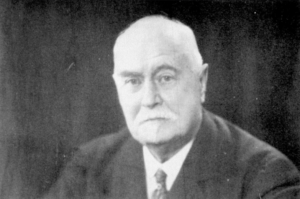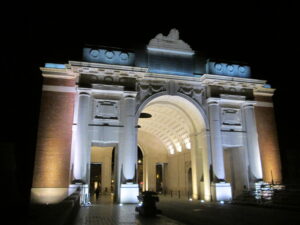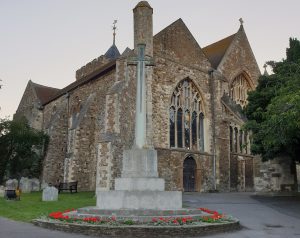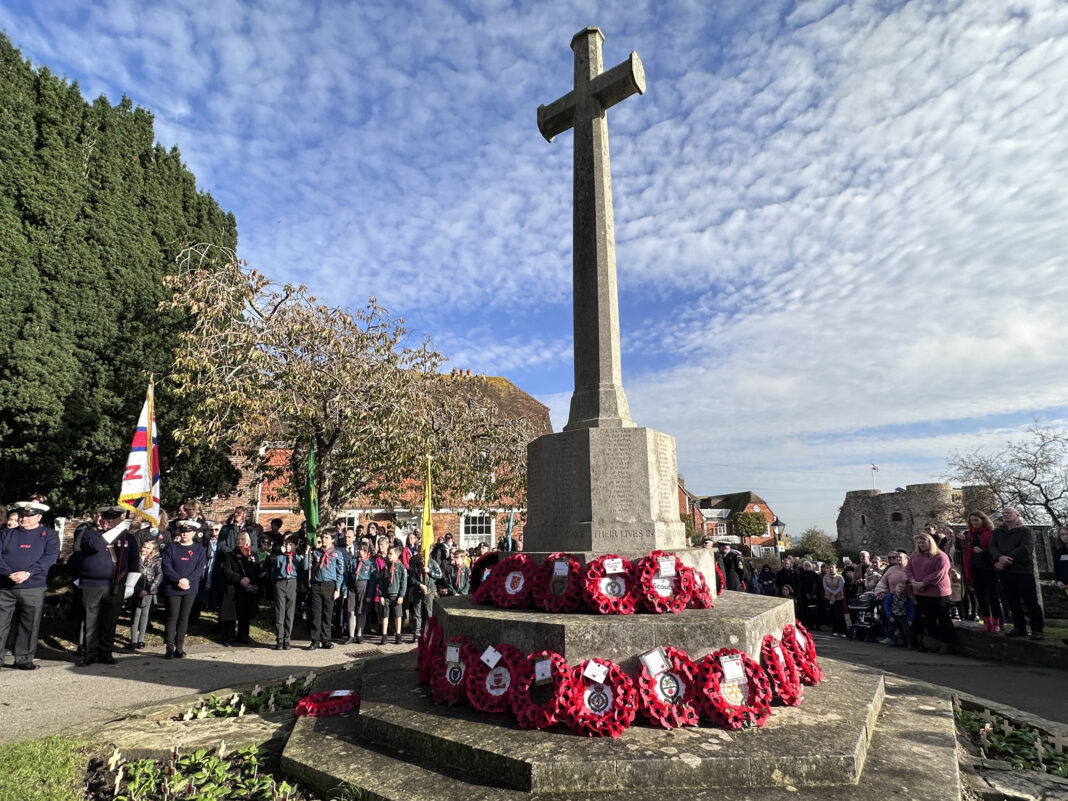At this time of year, we remember with respect and gratitude those brave men and women who have given their lives for our country in time of war and, sadly, in what is supposed to be peace. As always in Rye, a parade and church service takes place at 11am on Remembrance Sunday. You can read more details here.
The people of Rye then gather every year, to pay their respects, and think of their own lost loved ones, at the fine war memorial within the south eastern entrance of the churchyard of St Mary’s. This is an outstanding example of the work of Sir Reginald Blomfield, a local man by adoption (he was born in Devon,) who in 1886 had married Anne Burra, daughter of another local man, Henry Burra, of Springfield Lodge.

Blomfield designed his own house on Point Hill, a fine row of houses, all designed by him, during the 1890s. He was responsible for the new vicarage in 1887, followed by a mission room in 1900. In 1903 he worked on Leasam, making alterations to the house and creating a new garden. In 1905 he created Saltcote Place, Playden, for the Hennessy family. Blomfield was a prolific designer of war memorials for what was originally the Imperial War Graves Commission, now Commonwealth rather than imperial.
Many examples of his war memorials can be seen in the vast cemeteries in France, but probably the most notable is the monumental Menin Gate at Ypres in Belgium, a place that bore witness to some of the bloodiest fighting during the Great War. There, the French force was largely decimated when the Germans unleashed 200 tons of chlorine gas. British and Commonwealth losses during the fighting at Ypres were in the region of 300,000 men. Nearly 100,000 have no known grave. Blomfield designed the memorial in 1921 and it was unveiled in 1927.

The Rye memorial is described as “a two-stepped base surmounted by two stone blocks, a plinth and a tapering shaft with a cross of sacrifice with a metal sword on the face of the cross with the inscription carved into the sides of the blocks.”
An inscription on the memorial says: “In memory of the officers and men from Rye who gave their lives in the Great War, MCMXIV-MCMXIX. Their name liveth for evermore.” There are 145 names from the Great War and 48 from the second world war, including a volunteer from the Home Guard and eight civilians killed in bombing raids. The latest name is from the Gulf War. The memorial is made of Bath stone.

The war memorial in Rye was unveiled on October 19 1919 by Lord Leconfield of Petworth House, the lord lieutenant. He was paying his first visit to Rye. Although it was a solemn occasion, he was impressed by what he saw and promised to return on a private visit with Lady Leconfield. Amongst those attending the unveiling was Blomfield himself. He was praised by the mayor for designing the cross and arranging all the details but making no charge for his work. Blomfield made a reply, saying that it had been a pleasure to do what he could, and was always pleased to do anything to help the town, to which he felt a close connection.
Blomfield died at his house in Hampstead on December 27 1942, and was brought back to Rye, to lie in the family burial plot at St Michael’s, Playden.
The memorial was grade II listed following a long campaign in 2018.
Image Credits: KT Bruce , Commonwealth War Graves Commission CC , Wikimedia Commons , Anthony Kimber .




Thank you so much for this, it is humbling and educational.
Lest we forget, war is a terrible thing and the memorials are a needed reminder of this.
I still thank all those who died for us then and our freedom of today.
Really interesting article, thank you. I believe he designed the first electricity pylons also.
Think he chose the winning design, having been appointed to do so by the CEB in July 2027 (as a PR exercise by the CEB to reassure the public thst the metal monoliths would have some architectural credibility) and may have tinkered at the edges on an off the peg design from American engineers, the Milliken Brothers.
Appreciate the piece about Sir Reginald Blomfield, architect. Just to add that in addition to
the many war memorials, he designed and built Rye Hospital in 1921 as a memorial to the
fallen of WWI. It was rebuilt in 1994 in the same footprint and is nowadays officially known
as The Rye & Winchelsea Memorial District Hospital.
Every year at 11am on 11th November a volunteer climbs on to the Hospital roof and solemnly strikes the memorial bell, the signal for a two minute silence to be observed by the small gathering of Friends below in Reception. A wreath is laid beneath the memorial frames on the wall which record the names of the many members of the armed forces from all the villages in the District who were lost in the conflicts. The citations are uttered and there are prayers and a hymn.
My grandfather died in there on the 9th December 1942 of wounds received from the enemy on the 6th December in Rye.